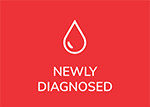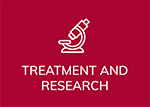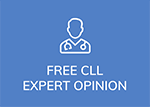
Venetoclax (ven ET oh Klax) which is marketed under the tradename of Venclexta® in the U.S. and Canada, is a selective inhibitor of B-cell chronic lymphoma 2 (BCL-2). BCL-2, an anti-apoptotic protein is overexpressed in CLL and mediates tumor cell survival and has been associated with resistance to conventional chemotherapy. Venetoclax essentially works by restoring the normal pathway of apoptosis or cell death which is disrupted by the over-expression of BCL-2 in the tumor cell.
The first approval for Venclexta® by the Food and Drug Administration (FDA) in 2016 was for the treatment of CLL with 17p deletion in patients who have received at least one prior treatment. Unlike chemotherapy and similar to other “novel” agent such as ibrutinib, acalabrutinib, idelasib and duvelisib, venetoclax works for patients with 17p deletion or mutated TP53.
Since then it was been approved as the only fixed duration frontline non-chemotherapy regimen (12 months) in CLL when used in combination with obinutuzumab. Please see: May 15, 2019: FDA approved venetoclax in combination with obinutuzumab for the treatment of people with previously untreated chronic lymphocytic leukemia (CLL) or small lymphocytic lymphoma (SLL) for more details on this approval and the pivotal trial.
Venetoclax is also approved in combination with rituximab as a fixed duration, in this case for ∼24 months in relapsed and refractory disease.
Venclexta® has a target dose of 400mg per day, which is dispensed as four 100mg tablets. However, because this drug is associated with rapid cell death and an increased risk of Tumor Lysis Syndrome (TLS), the dosage is slowly tapered up or increased over a five-week schedule to reach the full dose. To facilitate this schedule, the manufacturer provides a starter pack which is color-coded to maximize safety. The following is the taper schedule recommended for Venclexta:
- Week 1 20mg (2 – 10mg tabs) daily
- Week 2 50mg (1 – 50mg tab) daily
- Week 3 100mg (1 – 100mg tab) daily
- Week 4 200mg (2 – 100mg tabs) daily
- Week 5 + after 400mg (4 – 100mg tabs) daily
Depending on the severity of the disease as measured by tumor burden, some patients must be admitted as inpatients for the first two weeks of the ramp-up. In addition, it is critical that patients being treated with venetoclax drink a minimum of 1.5 to 2 quarts of water or other beverages each day. In addition, your provider will likely start you on the anti-gout medication Allopurinol when you start Venetoclax because there is a possibility that the drug may cause a phenomenon known as Tumor Lysis Syndrome (TLS). In TLS the malignant cells rupture and in doing so release large quantities of uric acid. Gout is the manifestation of increased uric acid levels and the allopurinol enhances the excretion of uric acid both in gout and TLS.
When taking Venetoclax, it is important to take it at approximately the same time each day and with a meal. It is important to swallow the tablets whole and to not break, crush or chew them.
In addition, there are numerous drug-to-drug interactions to consider as well, I will only discuss the most significant ones.
Many HIV and antifungal drugs inhibit the enzyme that metabolizes venetoclax which then results in increased blood levels and side effects. The HIV drugs can be recognized because they end in “Vir” and the antifungals end in “Zole”. In addition, the antibiotics clarithromycin, erythromycin and ciprofloxacin and the cardiac drugs diltiazem and verapamil have the same effect.
On the opposite side are drugs that induce the enzyme that metabolizes venetoclax and reduces the blood levels and may render the drug sub-therapeutic. These include the anti-seizure medications, phenytoin and carbamazepine, the anti-tubercular agents, rifampin, rifabuten and rifapentin, and the herbal product, St. John’s Wort.
Your provider will evaluate the risks of these interactions and decide to either adjust therapy or potentially switch to similar agents for the same purpose that do not interact with venetoclax. I must caution that the listing I have provided is only a small group of more significance. This is why you must discuss all current and contemplated new medications with all your medical team, including your primary care provider.
There are some serious food interactions to consider as well. Grapefruit, Grapefruit Juice and Seville Oranges inhibit the enzyme that metabolizes Venetoclax and the drug levels increase, risking worsening of potential side effects. Seville oranges are often used to make orange marmalade and should be avoided.
The list of POTENTIAL side-effects is long. Some are merely a nuisance and tend to be transient, and others are more severe and require medical intervention. Seek immediate medical attention for:
- Any signs of an allergic reaction, such as rash, hives, tightness in the chest or throat, trouble breathing or talking, swelling of the mouth, tongue or throat.
- Signs of bleeding internally, such as throwing up what looks like coffee grounds, blood in the urine or black, red or tarry stools.
- Signs of infection, like chills, very bad sore throat, ear or sinus pain, cough, more sputum or change in color of sputum, pain with urination, or a wound that will not heal
- Shortness of breath, sudden weight gain of more than 5 pounds or swelling in the arms or legs
- Signs of low potassium, like muscle pain, muscle cramps or a heartbeat that does not feel normal
Venetoclax is a breakthrough in the treatment of CLL. It is generally a safe and well tolerated medication, but all medications have risks. By educating yourself and listening to your body, you will likely benefit from this drug and be able to identify potential problems and risks in your treatment.
Thomas Henry is a Registered Pharmacist and CLL Patient. He is President and Senior Consultant for Burlington Consulting Associates, a company that provides consulting services to health systems nationwide. Tom is a CLL Society Medical Advisory Board member and strives to educate other CLL patients through his blog https//www.cllpharmacist.com. He has a forty-two-year career in pharmacy and has served as Chief Pharmacy Officer at two Top-15 Comprehensive Cancer Centers, Moffitt (Tampa, FL) and Roswell Park (Buffalo, NY).
Originally published 12/28/17 in The CLL Tribune Q4 2017. Updated 5/4/2020.

















